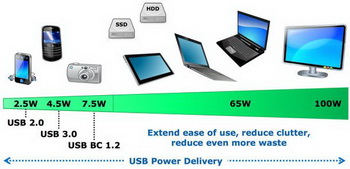OOPS! You forgot to upload swfobject.js ! You must upload this file for your form to work.
USB cable will power units up to 100 W
![]()
|
xtreview is your : Video card - cpu - memory - Hard drive - power supply unit source |
|
|||
|
|
||||
 Recommended : Free unlimited image hosting with image editor
Recommended : Free unlimited image hosting with image editor
|
POSTER: computer news || USB CABLE WILL POWER UNITS UP TO 100 W |
DATE:2012-09-15 |
|
|
Using the USB connector for charging mobile phones already allows to some extent to solve the problem of interoperability between devices of different models, as well as to ensure the continuity and universal power supply. However, further progress in phones USB charging is not moving. USB 2.0 Cable powered device are capable of up to 2.5 W, USB 3.0 cable raises the ceiling to 4.5 watts, and only a special version of USB BC 1.2 interface provides power for devices up to 7.5 w .Intel in collaboration with other stakeholders USB-IF is trying to increase the performance of power devices that can be powered from a USB cable.  Thus, the specification USB PD (power delivery) provides power to the USB cable for handheld devices up to 10 watts, tablets and peripherals up to 18 watts, light notebooks up to 36 W, average laptops up to 60 W, and monitors and all in one PC up to 100 watts. Intel will support the initiative with Hewlett-Packard, Intel, Microsoft, Renesas Electronics, ST-Ericsson, Texas Instruments and Nokia. The first devices with USB PD will appear at the end of this year. Related Products : | ||
|
|
||
|
xtreview is your : Video card - cpu - memory - Hard drive - power supply unit source |
|
|
|
|
||
|
Xtreview Support  N-Post:xxxx Xtreview Support        |
USB CABLE WILL POWER UNITS UP TO 100 W |
| Please Feel Free to write any Comment; Thanks  |
Direct connection of USB-C cable to devices with HDMI port (2016-09-01)
Intel 750 solid-state drives are equipped with a cable for connecting to a slot M.2 (2016-06-08)
Power supply be quiet! will be equipped with black cables (2016-05-10)
Adata introduced Micro USB-cable with dual connector USB Type-A (2016-03-27)
Oculus Rift will not go past four meters With standard cables (2016-01-08)
Cable Silverstone CPU01 is equipped with two-way plug Micro USB (2016-01-08)
Oculus VR considers cables obstacle to the success of virtual reality (2015-11-04)
SuperMHL video with a resolution of 8K and 40 watts of power in one cable (2015-01-08)
USB 3.0 cable can be used to connect 5K-display (2015-01-07)
AeroCool KCAS M - PSU power from 650 to 1000 watts with a detachable cable (2014-12-29)
Samsung offers a proprietary cable for charging mobile devices from each other (2014-09-24)
Lightning-cable with two-sided USB connector (2014-08-18)
Corning USB3 Optical _Cable (2014-04-17)
Thunderbolt optic cables are longer and more expensive (2014-01-14)
The first optical cables for Thunderbolt ports (2013-09-13)
Mass production of optical cables Thunderbolt (2013-01-04)
Intel will show at CES 2013 set-top box for cable networks (2012-12-31)
A new cable for headphones (2012-12-20)
Cable USB-Lightning appeared on sale (2012-10-20)
USB cable will power units up to 100 W (2012-09-15)
![]()
To figure out your best laptops .Welcome to XTreview.com. Here u can find a complete computer hardware guide and laptop rating .More than 500 reviews of modern PC to understand the basic architecture


7600gt review
7600gt is the middle card range.
We already benchmarked this video card and found that ...

 geforce 8800gtx and 8800gts
geforce 8800gtx and 8800gts  Xtreview software download Section
Xtreview software download Section  AMD TURION 64 X2 REVIEW
AMD TURION 64 X2 REVIEW  INTEL PENTIUM D 920 , INTEL PENTIUM D 930
INTEL PENTIUM D 920 , INTEL PENTIUM D 930  6800XT REVIEW
6800XT REVIEW  computer hardware REVIEW
computer hardware REVIEW  INTEL CONROE CORE DUO 2 REVIEW VS AMD AM2
INTEL CONROE CORE DUO 2 REVIEW VS AMD AM2  INTEL PENTIUM D 805 INTEL D805
INTEL PENTIUM D 805 INTEL D805  Free desktop wallpaper
Free desktop wallpaper  online fighting game
online fighting game  Xtreview price comparison center
Xtreview price comparison center Lastest 15 Reviews


Rss Feeds
Last News
- The new version of GPU-Z finally kills the belief in the miracle of Vega transformation
- The motherboard manufacturer confirms the characteristics of the processors Coffee Lake
- We are looking for copper coolers on NVIDIA Volta computing accelerators
- Unofficially about Intels plans to release 300-series chipset
- The Japanese representation of AMD offered monetary compensation to the first buyers of Ryzen Threadripper
- This year will not be released more than 45 million motherboards
- TSMC denies the presentation of charges from the antimonopoly authorities
- Radeon RX Vega 64 at frequencies 1802-1000 MHz updated the record GPUPI 1B
- AMD itself would like to believe that mobile processors Ryzen have already been released
- AMD Vega 20 will find application in accelerating computations
- Pre-orders for new iPhone start next week
- Radeon RX Vega 57, 58 and 59: the wonders of transformation
- ASML starts commercial delivery of EUV-scanners
- The older Skylake processors with a free multiplier are removed from production
- Meizu will release Android-smartphone based on Helio P40
- AMD Bristol Ridge processors are also available in American retail
- The fate of Toshiba Memory can be solved to the next environment
- duo GeForce GTX 1080 Ti in GPUPI 1B at frequencies of 2480-10320 MHz
- New Kentsfield overclocking record up to 5204 MHz
- Lenovo released Android-smartphone K8

HALO 3 HALO 3 - Final Fight!

PREY Prey is something you don t often see anymore: a totally unigue shooter experience.

computer news computer parts review Old Forum Downloads New Forum Login Join Articles terms Hardware blog Sitemap Get Freebies


